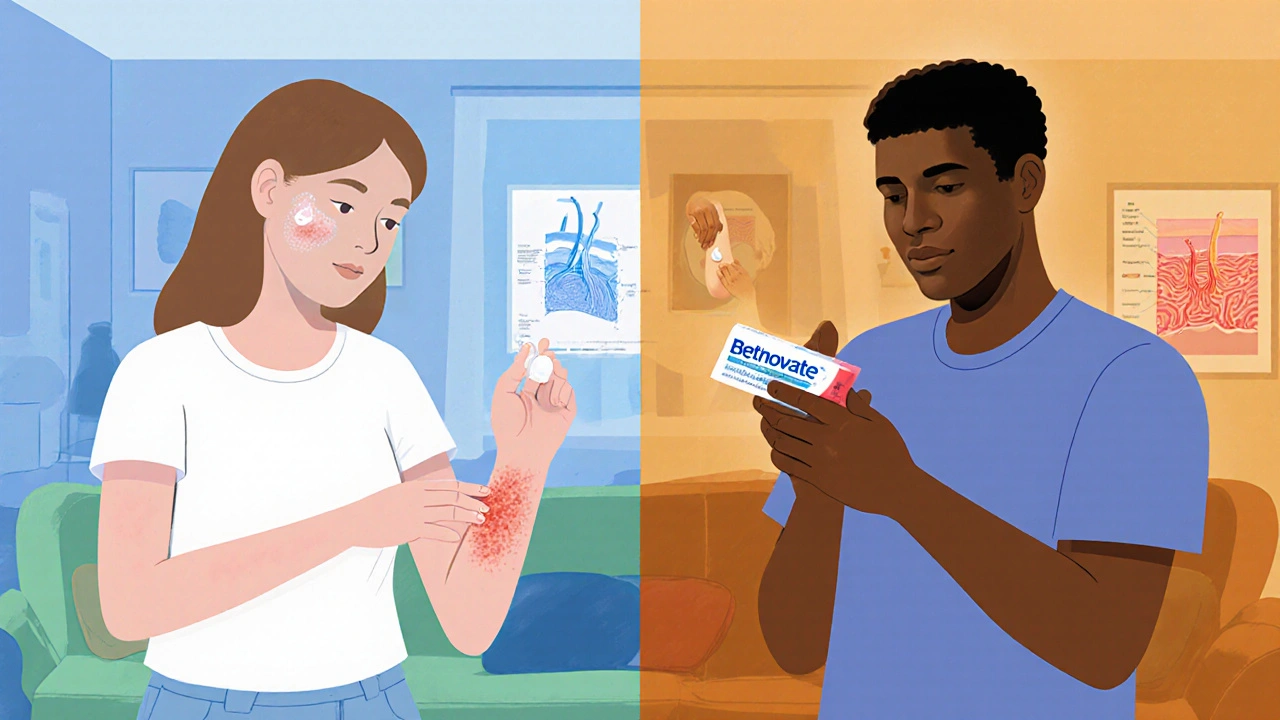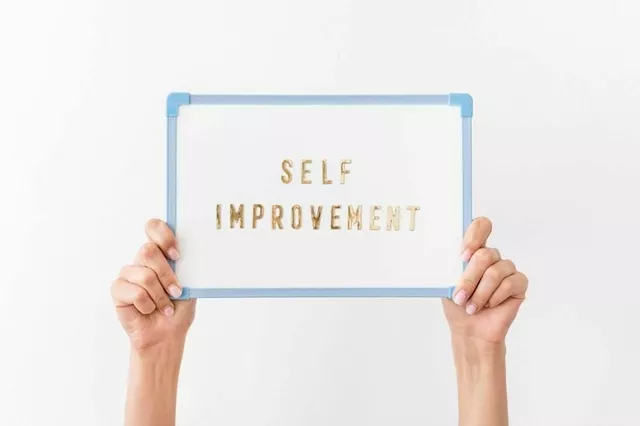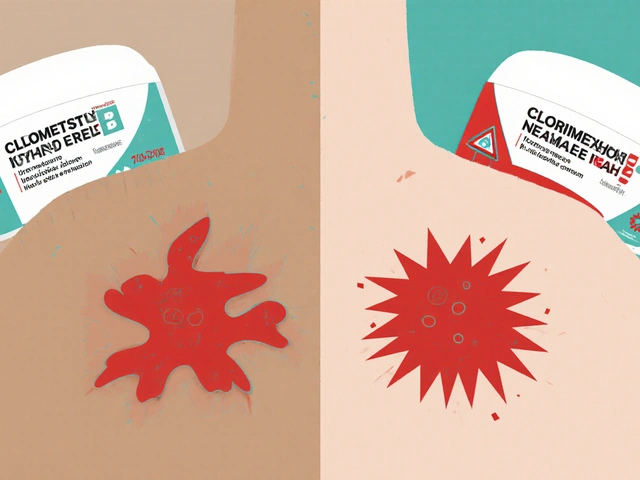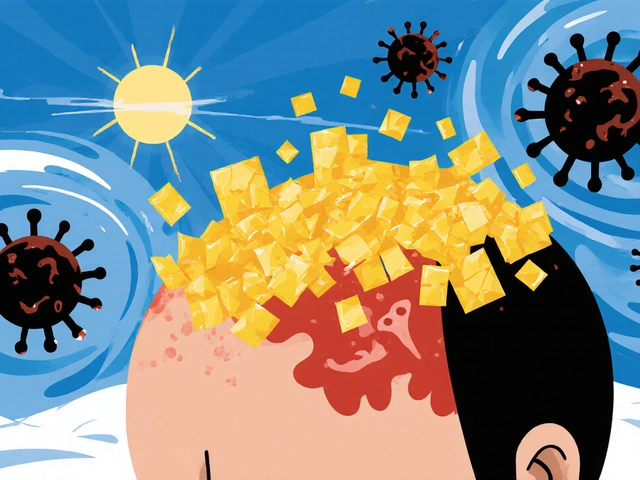
Topical Steroid Selector
Select Your Skin Condition
Betnovate is a prescription‑only topical corticosteroid containing betamethasone valerate 0.1%, used to calm inflammation, itching, and redness in conditions like eczema, psoriasis, and dermatitis. While it’s a go‑to for many dermatologists, dozens of other steroids sit on the market, each with its own strength and safety profile. This guide walks you through the most common alternatives, compares key attributes, and helps you decide which cream fits your skin’s needs.
How Betnovate Works
Betamethasone belongs to the class of corticosteroids. It binds to glucocorticoid receptors in skin cells, dampening the inflammatory cascade by reducing cytokine production and immune cell infiltration. The result is rapid relief of itching and swelling, often within hours of the first application.
Common Topical Steroid Alternatives
Below are the most frequently prescribed rivals, each defined once with microdata for easy reference.
- Hydrocortisone is a low‑potency steroid (0.5-2.5%) commonly found over the counter, suitable for mild irritations and sensitive skin areas.
- Clobetasol propionate is a super‑high‑potency steroid (0.05%) reserved for severe plaque psoriasis or thickened lesions where weaker agents fail.
- Mometasone furoate offers mid‑to‑high potency (0.1%) with a favorable safety record, often chosen for chronic eczema or lichen planus.
- Fluocinonide is a high‑potency steroid (0.05%) that penetrates deep skin layers, making it effective for stubborn dermatitis.
- Triamcinolone acetonide sits in the middle of the potency spectrum (0.025-0.1%) and is popular for both inflammatory and allergic skin conditions.
Potency & Indications at a Glance
| Agent | Potency Level | Typical Indications | Prescription Status |
|---|---|---|---|
| Betnovate | High | Eczema, psoriasis, allergic dermatitis | Prescription |
| Hydrocortisone | Low | Mild irritants, diaper rash | OTC |
| Clobetasol propionate | Super‑high | Severe plaque psoriasis, thick lichenified lesions | Prescription |
| Mometasone furoate | Mid‑to‑high | Chronic eczema, atopic dermatitis | Prescription (some OTC in low dose) |
| Fluocinonide | High | Stubborn dermatitis, psoriasis flares | Prescription |
| Triamcinolone acetonide | Mid | Allergic reactions, insect bites | Prescription |

Safety Profile & Side‑Effect Risks
All topical steroids can thin the skin, cause telangiectasia, or trigger adrenal suppression if used excessively. Betnovate’s high potency means it’s more likely to cause skin atrophy when applied to thin areas (face, skin folds) for longer than two weeks. In contrast, hydrocortisone’s low strength rarely leads to systemic effects, making it a safe starter for beginners.
Clobetasol propionate, while powerful, carries the highest risk of hypothalamic‑pituitary‑adrenal (HPA) axis suppression. Fluocinonide sits somewhere in the middle-effective, but clinicians advise a “pulse” regimen (3‑5 days on, 2‑3 days off) for chronic cases. Mometasone furoate enjoys a reputation for fewer striae and less rebound inflammation, which is why many dermatologists favor it for long‑term eczema management.
Choosing the Right Steroid: A Decision Guide
- Assess severity. Mild redness ↔ hydrocortisone. Moderate to severe plaques ↔ Betnovate, fluocinonide, or mometasone.
- Consider location. Thin skin (eyelids, genitals) → lowest potency possible. Thick plaques on elbows/knees → higher potency like clobetasol.
- Duration of treatment. Short bursts (<2 weeks) are safe with most high‑potency agents. For chronic conditions, rotate to mid‑potency or intermittent schedules to avoid atrophy.
- Patient age. Children are more susceptible to systemic absorption; start with hydrocortisone or low‑dose mometasone.
- Co‑existing therapies. If using calcineurin inhibitors (e.g., tacrolimus) for flare‑prevention, combine with a low‑potency steroid to minimize side effects.
In practice, many physicians begin with a low‑potency option, step up to Betnovate if response is inadequate, and reserve clobetasol for stubborn lesions that haven’t improved after two to three weeks.
Related Concepts & Adjacent Topics
Understanding how skin barrier function interacts with steroids helps prevent future flare‑ups. Moisturizers that restore ceramide levels complement steroid therapy and often reduce the need for higher potency creams. Non‑steroidal anti‑inflammatories such as pimecrolimus or tacrolimus are useful for maintenance phases, especially in sensitive areas.
For patients worried about steroid phobia, educating them on correct thin‑layer application (pea‑size amount per affected area) and the “fingertip unit” method can boost adherence and lower misuse.
Bottom Line
If you need fast, robust relief for moderate‑to‑severe inflammation, Betnovate is a solid choice-just keep an eye on treatment length and avoid thin‑skinned zones. For milder cases or long‑term maintenance, hydrocortisone or mometasone might spare you the extra side‑effects. And when the disease truly won’t budge, dialing up to clobetasol under specialist supervision can be a game‑changer.

Frequently Asked Questions
Can I use Betnovate on my face?
Generally it’s not recommended because the facial skin is thin and prone to atrophy. If a dermatologist prescribes it, limit use to the lowest potency formulation and apply for no more than five days.
How does Betnovate compare to mometasone furoate?
Both are mid‑to‑high potency steroids, but mometasone has a slightly better safety margin for long‑term use, especially on the trunk and limbs. Betnovate works faster on thick plaques but carries a higher risk of skin thinning if over‑used.
Is over‑the‑counter hydrocortisone effective for eczema?
For mild to moderate eczema, 1% hydrocortisone can provide sufficient itch relief and reduce inflammation. Severe cases often need a prescription‑strength steroid like Betnovate.
What side effects should I watch for when using high‑potency steroids?
Look out for skin thinning, easy bruising, stretch marks, and discoloration. Systemic signs such as unexplained fatigue or weight loss could hint at adrenal suppression, especially if large areas are treated.
Can I combine Betnovate with moisturizers?
Yes, layering a fragrance‑free moisturizer after the steroid has absorbed (about 15 minutes) can reinforce the skin barrier and may reduce the amount of steroid needed.
How long should I treat a psoriasis flare with Betnovate?
Typically no longer than two weeks. If the plaque persists, discuss tapering strategies or switching to a different agent with your dermatologist.
Are there non‑steroidal options for chronic eczema?
Calcineurin inhibitors such as pimecrolimus and tacrolimus are steroid‑free alternatives that work well for maintenance therapy, especially on the face and neck.









17 Comments
Betnovate is the go‑to for American skin care, nothing beats it 🇺🇸💪
Topical corticosteroids are a cornerstone of dermatologic pharmacotherapy, delivering anti‑inflammatory effects directly to the epidermis. Their mechanism hinges on glucocorticoid receptor agonism, which down‑regulates NF‑κB signaling cascades. Betnovate (betamethasone valerate 0.1%) occupies the high‑potency tier, situating it between mid‑strength agents like mometasone and super‑potent formulations such as clobetasol. When clinicians select a steroid, they balance potency against the anatomical site, duration of exposure, and patient comorbidities. For thin‑skinned regions-face, intertriginous zones-low‑potency hydrocortisone or a mild methylprednisolone cream is usually sufficient. Conversely, hyperkeratotic plaques on elbows or knees may necessitate a high‑potency cream to achieve adequate dermal penetration. The pharmacokinetic profile of betamethasone includes a rapid onset of itch relief, often within 30 minutes of application. However, its lipophilicity also predisposes to systemic absorption if applied over large body surface areas. The risk matrix for adverse events-telangiectasia, striae, HPA‑axis suppression-scales with both potency and treatment duration. Empirical guidelines recommend a “pulse” regimen for Betnovate: two weeks on, followed by a tapering interval to mitigate rebound inflammation. In pediatric populations, the risk–benefit calculus tilts toward the lowest effective potency, rendering hydrocortisone a more prudent first‑line option. Comparative studies have demonstrated that mometasone furoate produces comparable efficacy to Betnovate with a slightly more favorable side‑effect profile in chronic eczema. Fluocinonide, while potent, carries a higher propensity for skin atrophy when used beyond four weeks on a continuous basis. Clobetasol propionate should be reserved for refractory cases, given its classification as a super‑high‑potency agent. Patient education on proper application-thin layer, fingertip unit measurement-remains a cornerstone of safe steroid use. Ultimately, individualized therapy, guided by lesion severity, anatomical considerations, and patient preference, yields the most sustainable outcomes.
Navigating the steroid ladder can feel like a roller‑coaster 🎢, but the key is matching strength to the skin’s tolerance. Betnovate shines when you need that rapid, high‑potency punch for stubborn eczema, yet it’s a heavyweight that deserves respect. For everyday irritations, a humble hydrocortisone can keep the itch at bay without the drama of thinning skin. Think of it as choosing a sports car versus a family sedan-both get you there, but one drinks more fuel. 🌟
The discourse surrounding topical steroids invariably drifts into a dialectic of power and prudence. Betnovate, with its high glucocorticoid activity, exemplifies the apex of therapeutic authority, yet the same potency can erode the very barrier it seeks to protect. One must contemplate the paradox of using a potent weapon to treat a delicate surface without precipitating collateral damage. Clinical evidence underscores the necessity of temporal limitation, lest systemic repercussions arise. The dermatologist, therefore, becomes an arbiter, balancing efficacy against the ontological integrity of the epidermis. In practice, this translates to judicious prescription, patient education, and vigilant monitoring. The ethical imperative is clear: wield strength responsibly.
A careful look at the marketing of Betnovate reveals a coordinated effort by big pharma to dominate the steroid market. The glossy brochures emphasize rapid relief while conveniently downplaying the risk of adrenal suppression. Independent studies, often buried in pay‑walled journals, suggest comparable efficacy from generic alternatives that are quietly omitted. One cannot rule out the possibility that regulatory agencies are swayed by lobbying dollars. Patients deserve transparent data, not a curated narrative that serves corporate interests. Until the veil is lifted, skepticism remains the healthiest prescription.
Your analysis captures the ethical tightrope, yet it neglects the patient’s lived experience of chronic itching. Science alone cannot dictate comfort; the urgency to quell inflammation often outweighs abstract concerns about epidermal integrity. When a flare devastates daily function, the trade‑off becomes tangible. Thus, high‑potency agents, judiciously applied, can be justified as a compassionate choice. Balance, as you note, must be grounded in real‑world outcomes.
i think you rignht but toomuch potancy can cause skine thining if not watchd carefully
Great breakdown! 🌈 Matching potency to the lesion is like fitting the right key to a lock. Remember to educate patients on the fingertip‑unit method to avoid over‑application. Consistency and patience often win over the temptation for a quick fix. 😊
Education on dosing prevents overuse and side effects.
The interplay of molecular signaling and patient perception reflects a deeper truth: medicine is both art and chemistry. 🌿 Recognizing the psychosocial relief from rapid itch control can be as vital as the pharmacodynamics itself.
Honestly the phtologic details you mentioned are oversimplified; betamethasone's receptor affinity exceeds that of mometasone by a factor of two, which translates to a faster downregulation of cytokine cascades. Also, pulse therapy is not just a suggestion-clinical guidelines mandate it for any high‑potency topical used beyond 7 days. Failure to follow this can lead to iatrogenic adrenal suppression.
Even if big pharma pushes their products we can still make smart choices for our skin health and find affordable alternatives that work just as well
Your optimism is commendable and reflects a constructive approach to navigating the complexities of dermatologic therapy. While it is true that market forces can influence prescribing patterns, the clinician’s duty remains to evaluate each formulation on its evidence base. Independent comparative trials have demonstrated that generic betamethasone preparations often match the efficacy of brand‑name products, providing cost‑effective options for patients. Moreover, patient adherence improves when the financial burden is reduced, which in turn enhances therapeutic outcomes. By maintaining a critical yet hopeful perspective, we empower both providers and patients to make informed decisions. It is also prudent to stay abreast of emerging data on newer low‑potency agents that may further expand our armamentarium. Ultimately, a balanced view that acknowledges both challenges and opportunities serves the best interests of skin health. Thank you for highlighting the positive side of this dialogue.
I feel the same way but sometimes the hype around new creams feels overwhelming and it’s hard to separate genuine benefit from marketing fluff the industry loves to spill over the real data you know the thing about steroids is they’re powerful tools yet they’re often demonized leading to patient fear and misuse it’s a delicate dance between efficacy and safety especially when we consider long term use in chronic conditions like eczema we need clear guidelines and honest communication from doctors and pharma alike it’s not about choosing the cheapest option but the most appropriate risk‑benefit profile for each individual and that requires time education and patience but we can get there if we keep the conversation open and grounded in science
Building on the earlier philosophical note, let’s consider the pharmacokinetic parameter of lipophilicity as a double‑edged sword-enhancing dermal penetration while also raising systemic exposure risk. By leveraging a step‑down protocol, clinicians can harness Betnovate’s potency initially and then transition to mid‑potency agents like mometasone for maintenance, thereby optimizing therapeutic windows.
Your assessment is accurate; a step‑down regimen aligns with both efficacy and safety standards.
Well done, Einstein 😏-looks like we finally found someone who can sum up the whole steroid saga in a single sentence!